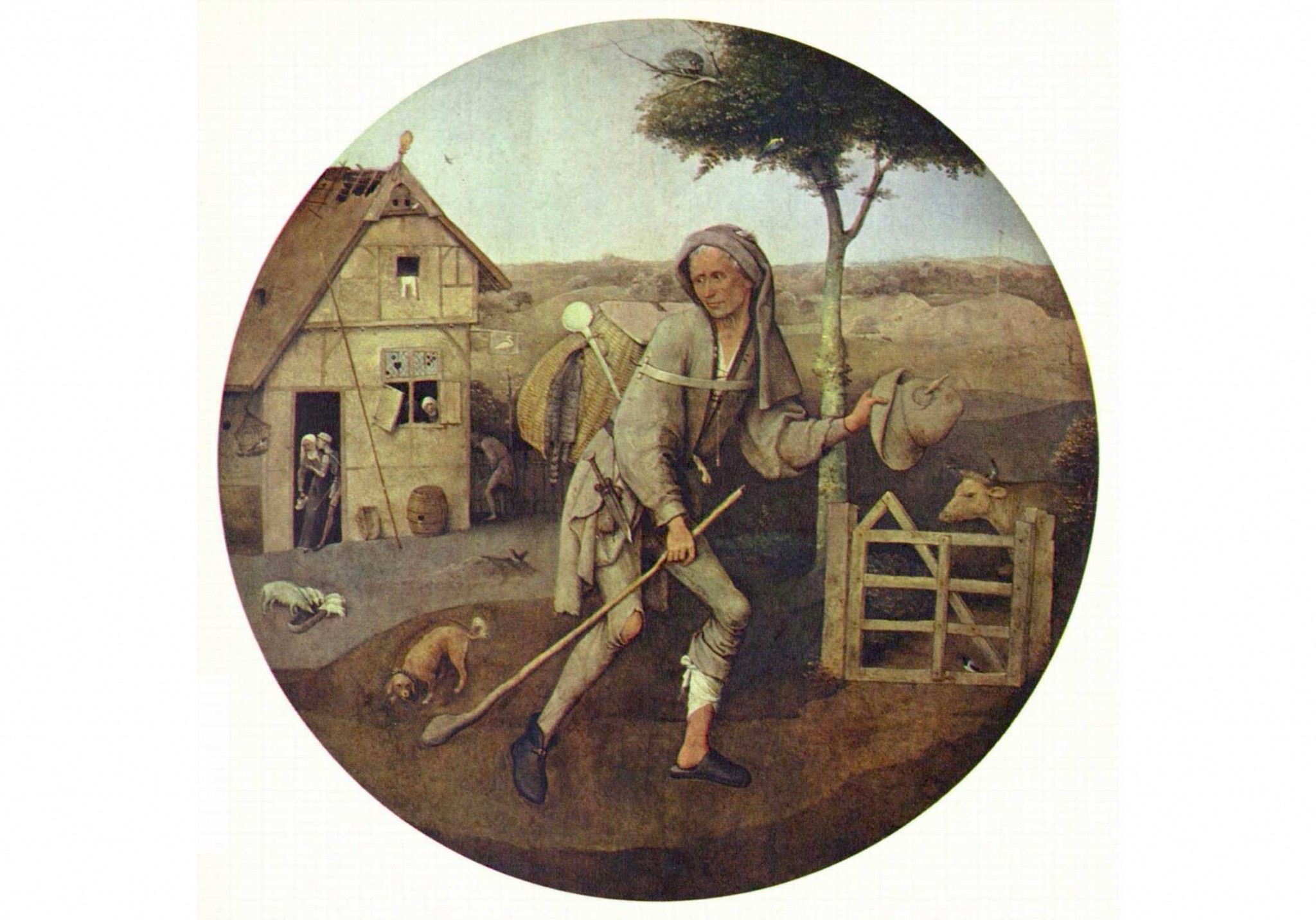
Pigler 1950
“Astrology and Jerome Bosch” (Andrew Pigler) 1950
[in: The Burlington Magazine, 92 (1950), pp. 132-136]
[Also mentioned in Gibson 1983: 50 (D38)]
In this article Pigler relates the exterior panels of the Haywain and the Rotterdam Pedlar tondo to late-medieval astrology. He rejects the Prodigal Son interpretation because of an argument already signalled before him (the grey hair of both protagonists) but also adds a new argument: the heavy burden carried by the tondo’s protagonist (who is indeed stooping forward a bit) doesn’t fit in with the complete poverty of the Prodigal Son when he is returning to his father’s house. Pigler also rejects the Wayfarer interpretation because of ‘certain elements in the painting’. According to Pigler Bosch borrowed the protagonist of both paintings from fifteenth-century astrological woodcuts, engravings and drawings that are called Planetenkinderbilder (representing the ‘children of the planets’). The man carrying a basket on his back is said to be a ‘child’ of the planet Saturn: his skinny outlook, his melancholic gaze and his slow, uncertain way of walking point at this. Pigler’s most important argument is the similarity he sees between Bosch’s protagonists and a figure carrying a heavy sack and a long stick in the foreground of a Florentine engraving, dated circa 1460 and representing the ‘children of Saturn’.
Actually, this engraving [p. 134, ill. 21] does not show even a remote similarity to Bosch’s pedlars. According to Pigler the same motif can also be seen in the period after Bosch, in a woodcut from Andrea Alciati’s Emblemata (1547-edition). But again: there is no similarity whatever to what Bosch painted [p. 135, fig. A]. Bernard Salomon, the inventor of the woodcut, is said to have been inspired by Bosch. The growling dogs in the exterior panels of the Haywain and in the tondo have become a weasel in the woodcut and in the accompanying text, but according to Pigler this is ‘just a detail’.
Pigler’s remaining arguments are just as weak. That pigs and gallows turn up in both Bosch paintings and in representations of the ‘children of Saturn’, may be considered an interesting observation, although this can just as well be sheer coincidence. But that the man who is slaughtering a horse in a Saturn drawing by the Master of the Amsterdam Cabinet [p. 134, ill. 23] would be an astrologic parallel of the skeleton of a horse in the exterior panels of the Haywain, is downright Hineininterpretierung. Moreover, Pigler loses a lot of credit by suggesting that the ‘cottage’ (by which he means the suspicious inn) in the Rotterdam tondo is the protagonist’s house and that his wife is already throwing herself in the arms of a soldier.
In the end, Pigler interprets the protagonists of Bosch’s paintings as lonely tramps who have come to lead unfortunate lives under the influence of the planet Saturn. Because of this the exterior panels of the Haywain are said to fit in well with the interior panels that are related – in an arbitrary way – to the Biblical passage Amos 2: 13-14 and interpreted as a warning of the inevitable punishment of sins, directed at humanity. After all this, one wonders why Bosch was inspired by late-medieval astrology when painting the exterior panels of this triptych, and not when he painted the interior panels.
In a footnote Pigler mentions that he was not able to read the articles of Grauls and Lebeer (1938): a lost opportunity, to say the least. Obviously, Pigler’s article is built on a weak foundation. He does not succeed in bringing together all the details of Bosch’s exterior panels and tondo within a harmonic interpretation. That the protagonists are pedlars, is never mentioned. The crucial role of the dogs is totally ignored. Pigler’s observation that the heavy burden of the tondo’s protagonist contradicts the Prodigal Son interpretation and, most important, his remark that it is an error not to relate the exterior panels and the tondo to each other, are the only valuable elements in his analysis of both paintings. The link that Pigler sees between the Conjuror panel (St Germain-en-Laye), a Bosch drawing with a conjuror (Louvre) and a Luna drawing in the fifteenth-century Hausbuch, is also interesting enough to be studied in a closer way. See further about this, Bax 1962: 30/35 and Hammer-Tugendhat 1981: 45-48.
About Pigler’s article, see also De Bruyn 2001a: 177.
[explicit]